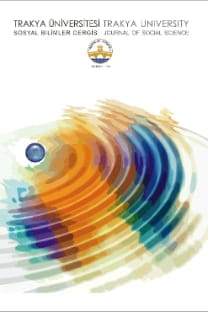Faktör Analizi Ve Veri Zarflama Analizi İle AB'ye Üye Ve Seçilmiş Bazı Ülkelerin Karşılaştırmalı Analizi
Eu Candıdate Country And Some Countrıes Comparative Analysıs And Data Envelopment Analysıs
___
- Alderson, J. C. (2000). Technology in Testing: The Present and Future. Elsevier Science Document System, (28), 593-603.
- Ailesi, S. M, & Troollip, S. R. (2001). Multimedia for Learning: Methods and Development. (3 rd Ed). Massachusetts : Allyn and Bacon Needham Heights. Anderson, R.C., Kulhavy, R.W., & Andre, T.(1971). Feedback procedures in programmed instruction. Journal of Educational Psychology, (62), 148-156.
- Aydın, A. (1999). Gelişim ve Öğrenme Psikolojisi (1. baskı). Ankara: Anı Yayıncılık.
- Batino, B. (1992). The Effects of Three Feedback Forms on Learning Through a Computer-Based Tutorial. Calico Journal, 10(1), 45-52.
- Cüceloğlu, D. (2002). İnsan ve Davranışı-Psikolojinin Temel Kavramları. İstanbul: Remzi Kitabevi.
- Çilenti, K. (1984). Eğitim Teknolojisi ve Öğretim (2. baskı). Ankara: Kadıoğlu Matbaası.
- Demirel, Ö. (2001). Öğretmenlik Mesleğine Giriş (1. baskı). Ankara: Pegem Yayıncılık.
- Dempsey, J. V., Driscoll, M. P., & Swindell, L. K. (1993). "Text-based feedback" In J.V. Dempsey & G.C. Sales, (Eds.), Interactive Instruction and Feedback, 21-54. Englewood Cliffs, NJ: Educational Technology.
- Ergin, A. (1995). Öğretim Teknolojisi İletişim (1. baskı). Ankara: Pegem Yayınları.
- Freedman, K. (1991). Possibilities of Interactive Computer Graphics for Art Instruction: A summary of research. Art Education, 44(3), 41-47.
- Gilman, D. A. (1996). Comparison of several feedback methods for correcting errors by computer-assisted instruction. Journal of Educational Psychology 60(6), 503-508. '"
- Gordjin, J., & Nijhof J. W. (2002). Effects of Complex Feedback on Computer-Assisted Modular Instructions. Computers & Education, 9, 183-200.
- Hoska, D. M. (1993). Motivating learners through CBI feedback: developing a positive learner perspective. In J.V. Dempsey & G.C. Sales, (Eds.), Interactive Instruction and Feedback. Englewood Cliffs, NJ: Educational Technology.
- Klein, J. D., & Keller, J. M. (1990). Influence of the student ability, locus of control and type of instructional control on performance and confidence. Journal of Educational Research, 83(3), 140-146.
- Kulhavy, R. W., & Wager, W. (1993). Feedback in Programmed Instruction: Historical Context and Implications for Practice. In J.V. Dempsey & G.C. Sales (Eds.), Interactive Instruction and Feedback, Englewood Cliffs. NJ: Educational Technology Publications.
- Lin, S. S. J., Liu, E. Z. F., & Yuan, S. M. (2001). Web Based Peer Assesment: Feedback For Students With Various Learning Styles. Journal of Computer Ass i ted Learning, (17), 420-432.
- Mory, H. E. (1992). The use of Informational Feedback in Instruction: Implications for Future Research. Educational Technology & Research Development, 40(3), 5-20.
- Mory, H. E. (1996). Feedback research. Journal of Educational Communications and Technology 4(2), 56-65.
- Ross, S. M., & Morrison, G. R. (1993). Using Feedback to Adapt Instructions for Individuals. In J.V. Dempsey & G.C. Sales (Eds.), Interactive Instruction and Feedback, Englewood Cliffs, NJ: Educational Technology Publication.
- Sales, G. C. (1993). Adapted and adaptive feedback in technology-based instruction. Englewood Cliffs, NJ: Educational Technology Publications, 1993, pp: 159-175.
- Wager, W., & Wager, S. (1996). Presenting Questions, Processing Responses, And Providing Feedback in CIA. Journal of Instructional Development, 8(4), 2-8.
- Yalın, H. İ. (2000) Eğitimde İletişim (3. baskı). Ankara: Nobel Yayın Dağıtım.
- ISSN: 1305-7766
- Yayın Aralığı: Yılda 2 Sayı
- Başlangıç: 2000
- Yayıncı: Trakya Üniversitesi Sosyal Bilimler Enstitüsü
Günümüz Biyoloji Eğitiminin Önemi
Türkiye İçin Küreselleşme Ve Enflasyon İle İlgili Bazı Sınamalar
Ömer ÖZÇİÇEK, Tuba BAŞKONUŞ DİREKÇİ
TÜRKİYE- AB GÜMRÜK BİRLİĞİ ANTLAŞMASI VE ANTLAŞMANIN TÜRKİYE EKONOMİSİNE ETKİLERİ
XVI-XVIII. YÜZYIL AVRUPA RESİM SANATI’NDA UŞAK HALILARI
Kırklareli İlinin Sosyoekonomik Kalkınmasında Mekan (ŞEHİR ) Pazarlamasının Rolü
Gülnur ETİ İÇLİ, Beste BURCU VURAL
OKULÖNCESİ VE ANAOKULU DAVRANIŞ ÖLÇEĞİNİNİN GEÇERLİK VE GÜVENİRLİK ÇALIŞMASI
Yeşim FAZLIOĞLU, Lale OKYAY, Gökhan ILGAZ
LOJİSTİK KÖYLERİN İŞLETMELERE SAĞLADIĞI MALİYET AVANTAJLARI
Muhammet BEZİRCİ, Abdullah Oktay DÜNDAR
Türkiye- Ab Gümrük Birligi Antlaşması Ve Antlaşmanın Türkiye Ekonomisine Etkileri
Sağlıkta Dönüşüm Uygulanması Sonrası Hastane Tercihlerindekiİ Değişimin İncelenmesi
Özlem DENİZ BAŞAR, Münevver TURANLI
SAĞLIKTA DÖNÜŞÜM UYGULAMASI SONRASI HASTANE TERCİHLERİNDEKİ DEĞİŞİMİN İNCELENMESİ
